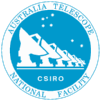Changes between Version 8 and Version 9 of Changes/uvsplit
- Timestamp:
- 11/22/07 15:09:15 (17 years ago)
Legend:
- Unmodified
- Added
- Removed
- Modified
-
Changes/uvsplit
v8 v9 7 7 Add a parameter to uvplit to split up wide bands into a number of sub-bands. This could either be a nsub type keyword specifying the number of bands to split into, or a maxbandwidth keyword to limit the maximum bandwidth of the output files. Some thought needs to go into the naming scheme of the output files, since sub-bands and zoom bands could have identical center frequencies. 8 8 9 The current naming scheme is to use the source name and center frequency (rounded to the nearest integer). For example, hh137.4800 (HH object 137 and 4800 MHz center frequency). CABB has the following possible modes (each band can have 4096 channels on both pols):9 The current naming scheme is to use the source name and center frequency (rounded to the nearest integer). For example, hh137.4800 (HH object 137 and 4800 MHz center frequency). The following defines CABB modes: 10 10 11 '''Wideband''' - One can select a single 2 GHz sub-band, on two pols. 12 13 '''Simple Zoom''' - One can select a 250MHz-wide band within the 2 GHz sub-band. 14 15 '''Multiple Zoom''' (> 2 possible) - One can select up to 8 250MHz-wide bands within each 2 GHz sub-band. 16 17 '''Compound zoom''' - a 2 GHz bandwidth can be split into 15 chunks, each of 16 MHz in width. 18 19 The above was extracted from the following document: 20 21 http://www.atnf.csiro.au/technology/electronics/docs/cabb/p1629.pdf 11 http://www.narrabri.atnf.csiro.au/observing/CABB.html 22 12 23 13 There is perhaps a functional overlap with the bbcal, which at the moment is proposed to split an 8GHz observation into 2GHz sub-bands.
